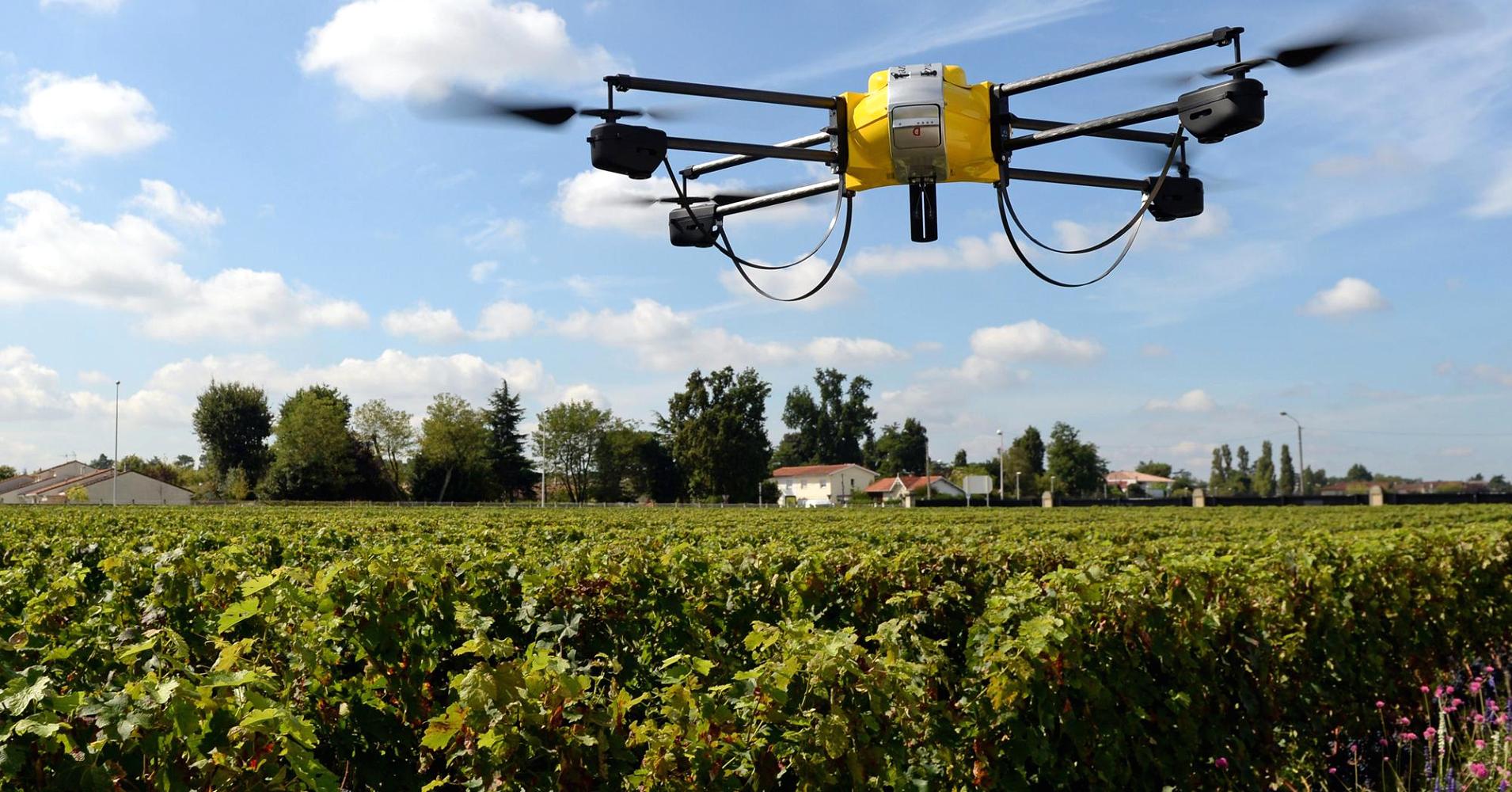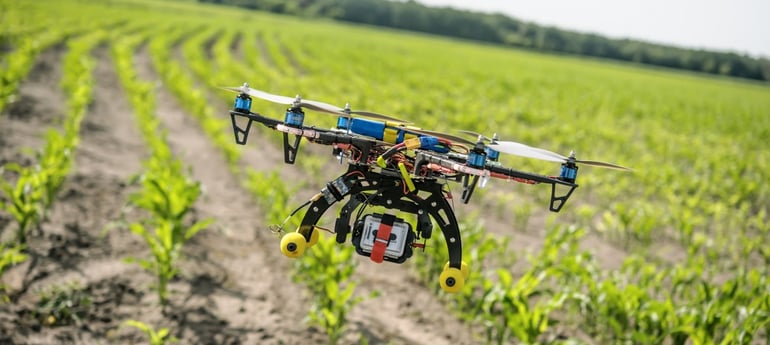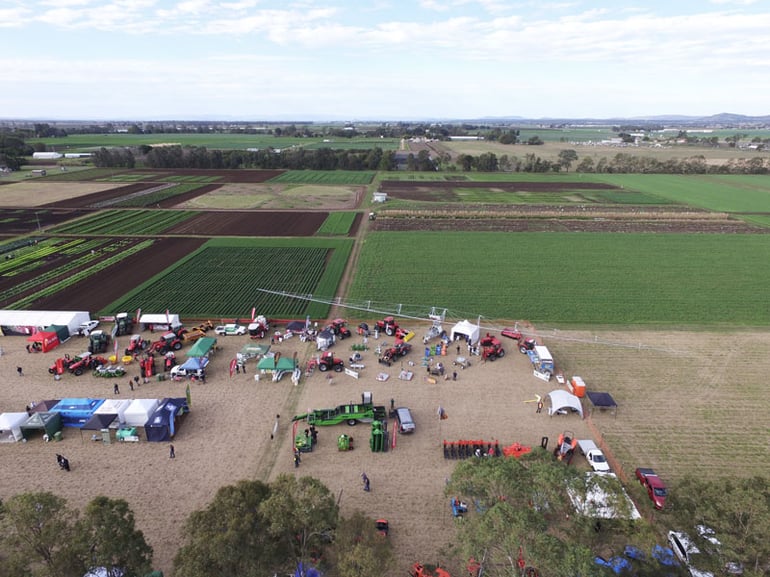How Drones, Computer Vision, and AI are Transforming the Agricultural Industry
Find out how drones, computer vision, and artificial intelligence are changing the way farmers grow crops and revolutionizing the food and beverage industry.

With the global population increasing by 83 million every year, many are questioning how we can meet the future’s demand for food. Forecasts predict there will be over eight billion human mouths to feed globally by the year 2030, providing a big challenge for the food and beverage industry. Whilst having enough space to produce food is one of the most widely discussed challenges, the biggest one lies in whether or not we can get enough manpower to do the jobs. Humans have their limits; they cannot work 24 hours a day to oversee thousands of acres of crops and grow more food.
Food and Beverage Industry experts, though, have a solution for this: technology.
Leveraging technology isn’t a new practice in the agriculture and food and beverage industries. We have already seen smart robots that can weed and pick-up apples, biometrics that can automatically deliver information about livestock in real time, and advanced machines that can pump milk from cows with little manpower required. But as technology advances, more intelligent inventions that could enhance farmers’ output and speed up crop production have also emerged. Drones, Artificial Intelligence, and computer vision are some of these exciting innovations that are transforming the industry.
DRONES MAY SAVE US FROM STARVATION
Drones, also referred to as unmanned aerial vehicles (UAVs), have grown from military flying machines that spy on targets from above to a real estate photographer's new favourite toy, and now to a revolutionary farming tool that’s touted to change the entire agricultural scene.
These “flying robots” are used today by agriculturists to take aerial images of their land. Since drones can fly over a field as high or as low as needed and can be equipped with cameras, it becomes easier for farmers to recognise potential issues that cannot be seen by the human eye or from the ground level. Issues like leaf color variation, crop stress, and irrigation leaks.
Given this edge, many food and beverage industry experts are predicting a bright future for this technology, in the agriculural industry. In fact, Successful Farming's 2016 Technology in Ag Study showed that 62% of the agricultural industry is looking forward to owning a drone in the near future. 17%, particularly, will own a drone within the next 1-2 years while 33% will adopt the farming technology within two or more years. Here in Australia, over the past 12 to 18 months, there has also been a rise in companies leveraging drones to assess crop health.

This statistic is no longer surprising though, considering the rapid improvement in drone technology. From capturing high-resolution photos from above, new features have now transformed the way farmers plant their crops and the way they plan for future production. This is through the addition of 3-D mapping. Strapped on board, the technology enables drones to collect vital information about field geography and soil composition, which could help farmers pinpoint the best areas to plant the next batch of seeds.
On top of this, drones can also decrease the costs of planting by as much as 85% and can help grow more crops without the need for additional manpower. The latest drones can be fitted with pod shooters that launch seeds or nutrients straight into crop fields. This means fields are planted much faster and more efficiently. Based on research, the plantation rate would be over 700-800 plants an hour - a number that’s quite impossible for average farmers to achieve. Normally, a grower would take around one to two days to finish the same task.
Drones can also be an excellent instrument in crop spraying. The machines can scan the entire field and spray the right amount of water or fertilizer in exact areas. According to experts, crop spraying through drones can be completed five times faster compared to traditional farm machinery.
With all these capabilities, it’s clear that drones are on a fast track to revolutionising the agricultural sector and solving the enormous problem of feeding a rapidly growing population, especially if the technology continues to advance. Right now, a plethora of companies are getting into the industry, offering this game-changing technology to help meet the future’s demand for food.
LOCAL AUSTRALIAN BUSINESSES GET IN ON THE ACTION
Among the many businesses breaking into what some are starting to call “precision agriculture” is Flying Ag Australia. The Queensland firm provides practical drone kits to local farmers and agribusinesses who are looking to use drones on their land. It claims that with its drones, Australian farmers can quickly identify potential problems, like pest infestations, and can save money and increase yields as they can easily determine the areas where nutrients need to be applied.
Another local company getting in on the action is Queensland Drones. Though the company specialises in delivering professional aerial photography, infrastructure surveys, and aerial mapping services, it also offers on-farm drone packages. Its Sentera Phantom 4 Scout comes with a Near Infrared (NIR) sensor that can help farmers map the health of their crops in real time.
 Photo: Queensland Drones
Photo: Queensland Drones
Overseas, meanwhile, we have MicaSense.
The Seattle startup sells this multispectral camera that when attached to a drone, can capture important data needed for accurate crop health analysis. The device lets workers measure plant reflectance and allows them to have a more scientific approach so they can further improve the output of their crops.
“There are people today who go to a field and literally walk around it looking for issues — it’s time-consuming and error-prone,” said MicaSense’s CEO and co-founder, Gabriel Torres. “Our camera enables much quicker capturing of data and can identify, on a quantitative basis, potential issues with things like water, pests, soil, and fertilizers.”
While the focus of Flying Ag Australia, Queensland Drones and MicaSense is on drones alone, other companies opt to combine drones with other technologies to make farming even smarter. The technologies we’re talking about are computer vision and Artificial Intelligence.
HOW COMPUTER VISION AND AI CAN HELP GROW MORE CROPS
When integrated into drones, computer vision technology can provide all kinds of essential data that can help farmers optimise irrigation and plan the best time for harvest. In particular, it can dramatically enhance the aerial images taken by drones to compute highly accurate information that would be impossible to glean just from images (or the naked eye), which agriculturists can use to make the best farming decisions. Today, several companies are offering this kind of technology to be used with drones.
Among them is Prospera. This Israeli company makes use of cameras and climate sensors to analyse leaves and detect pests and possible diseases in crops. “The technology gives farmers an extra set of eyes to constantly monitor what is happening in their greenhouses and fields, from individual leaves to upcoming weather patterns that can affect farms in a few days’ time,” explains Daniel Koppel, Prospera’s boss. The company claims that computer vision technology can boost yields by roughly 30%. Right now, Prospera’s system is already being used by farms in Mexico and Spain.
Lately, a growing number of farmers are turning to Artificial Intelligence to improve their productivity and yield more food. AI is a form of computer science that gives machines the ability to behave like they have “human intelligence”. AI is being paired with drones to further analyse aerial images and give agriculturists data that can help them lower planting costs, cut down water and fertilizer use, and monitor crop health.
Switzerland-based Gamaya is one of the startups employing both drones and AI to help farmers grow their crops cost effectively. The firm uses hyperspectral cameras mounted on drones to collect imaging data of the field and then utilises artificial intelligence to process the data and provide farmers with precise information on physiological traits and crop phenology. According to Gamaya, the data from its cameras can bring 10 times more information compared to other monitoring systems out there.
There’s more to AI than just image analysis, though.
Agriculturists also use it to keep an eye on crop conditions - such as soil moisture content and water scarcity conditions - and predict crop outcomes. In Texas, United States, there’s even a company named NatureSweet that uses AI to control pests and diseases in greenhouses and grow more tomatoes.
NatureSweet is a grower and seller of produce; it grows a variety of tomatoes on six of its farms in Mexico and U.S. About a year ago, it began testing the AI technology developed by Prospera at its Arizona farm and saw great results. Ccameras are installed in its greenhouse ceilings that take photos of the crops from above to then detect issues, including drying plants and insect infestation. So far, harvests have increased from 2% to 4%.
Benson Hill Biosystems, headquartered in Saint Louis, Missouri, is also a company that leverages artificial intelligence. Its CropOS™ platform uses AI to anticipate crop outcomes and find gene candidates to improve photosynthesis. Benson Hill and NatureSweet show that artificial intelligence can help growers produce more food and empower farmers by dramatically improving how they monitor and optimise crop growth.
Drones, computer vision, and artificial intelligence. While these technologies are still in their infancy, farmers and agribusinesses around the world are beginning see and understand the potential of these technologies to revolutionise the food and beverage industry. What’s important now, though, is that these advances in technology are already on their way to transforming the way we produce crops and to starting to provide a solution to feeding a planet of 8-billion people by 2030.
Want to read more articles like this? Visit the “Industry Insights” section on our blog.
Categories
Trends
Avlya Jacob is a content writer at Ordermentum. When not working, she enjoys writing online novels and spending time with her husband.







